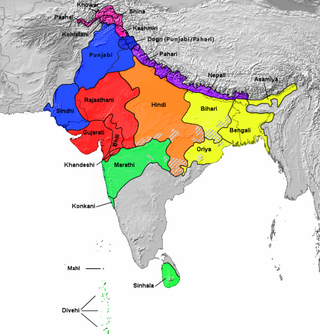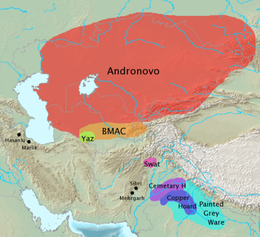Indo-Aryan peoples: Difference between revisions
| [accepted revision] | [accepted revision] |
→Contemporary: Miya are ethnoreligious not ethno-linguistic Tags: Mobile edit Mobile app edit Android app edit |
Nope. We don't legitimize fringe crankery here, and a book on religious experiences from a non-academic publisher isn't even close to the kind of sourcing we accept |
||
| Line 54: | Line 54: | ||
The theory posits that these Indo-Aryan speaking people may have been a genetically diverse group of people who were united by shared cultural norms and language, referred to as ''aryā'', "noble." Diffusion of this culture and language took place by patron-client systems, which allowed for the absorption and acculturalisation of other groups into this culture, and explains the strong influence on other cultures with which it interacted. The [[Proto-Indo-Iranians]], from which the [[Indo-Aryans]] developed, are identified with the [[Sintashta culture]] (2100–1800 BCE),{{sfn|Anthony|2007|p=390 (fig. 15.9), 405-411}} and the [[Andronovo culture]],{{sfn|Anthony|2009|p=49}} which flourished ca. 1800–1400 BCE in the steppes around the [[Aral sea]], present-day Kazakhstan, Uzbekistan and Turkmenistan. The proto-Indo-Iranians were influenced by the [[Bactria–Margiana Archaeological Complex|Bactria-Margiana Culture]], south of the Andronovo culture, from which they borrowed their distinctive religious beliefs and practices. The Indo-Aryans split off around 1800-1600 BCE from the Iranians,{{sfn|Anthony|2007|p=408}} whereafter the Indo-Aryans migrated into the [[Levant]] and north-western India.<ref>George Erdosy(1995) "The Indo-Aryans of Ancient South Asia: Language, Material Culture and Ethnicity.", p.279</ref> |
The theory posits that these Indo-Aryan speaking people may have been a genetically diverse group of people who were united by shared cultural norms and language, referred to as ''aryā'', "noble." Diffusion of this culture and language took place by patron-client systems, which allowed for the absorption and acculturalisation of other groups into this culture, and explains the strong influence on other cultures with which it interacted. The [[Proto-Indo-Iranians]], from which the [[Indo-Aryans]] developed, are identified with the [[Sintashta culture]] (2100–1800 BCE),{{sfn|Anthony|2007|p=390 (fig. 15.9), 405-411}} and the [[Andronovo culture]],{{sfn|Anthony|2009|p=49}} which flourished ca. 1800–1400 BCE in the steppes around the [[Aral sea]], present-day Kazakhstan, Uzbekistan and Turkmenistan. The proto-Indo-Iranians were influenced by the [[Bactria–Margiana Archaeological Complex|Bactria-Margiana Culture]], south of the Andronovo culture, from which they borrowed their distinctive religious beliefs and practices. The Indo-Aryans split off around 1800-1600 BCE from the Iranians,{{sfn|Anthony|2007|p=408}} whereafter the Indo-Aryans migrated into the [[Levant]] and north-western India.<ref>George Erdosy(1995) "The Indo-Aryans of Ancient South Asia: Language, Material Culture and Ethnicity.", p.279</ref> |
||
The alternate [[Indigenous Aryans]] theory places the Indo-Aryans languages as being entirely indigenous to the Indian subcontinent and later they spread outside the subcontinent; this theory is rejected by mainstream scholarship.{{sfn|Witzel|2001|p=95}}{{sfn|Jamison|2006}}{{sfn|Guha|2007|p=341}}{{sfn|Fosse|2005|p=438}} |
|||
==List of Indo-Aryan peoples== |
==List of Indo-Aryan peoples== |
||
Revision as of 03:56, 29 November 2019
 | |
| Total population | |
|---|---|
| ~1.3 billion | |
| Regions with significant populations | |
| over 911 million[1] | |
| over 204 million[2] | |
| over 160 million[3] | |
| over 26 million | |
| over 14 million | |
| over 1 million | |
| over 300,000 | |
| over 240,000[4] | |
| Languages | |
| Indo-Aryan languages | |
| Religion | |
| Indian religions (Mostly Hindu; with Buddhist, Sikh and Jain minorities) and Islam, Christians and some non-religious atheist/agnostic | |
| Part of a series on |
| Indo-European topics |
|---|
 |
The Indo-Aryan peoples or the Indic peoples are a diverse collection of ethnolinguistic groups speaking Indo-Aryan languages, a subgroup of the Indo-European language family. There are over one billion native speakers of Indo-Aryan languages,[not verified in body] most of them native to the Indian subcontinent and presently found all across South Asia, where they form the majority.[note 1]
History
Some of the theories proposed in the 20th century for the dispersal of Indo-Aryan languages are described by linguist Colin Masica in the chapter, "The Historical Context and Development of Indo-Aryan" in his book, The Indo-Aryan Languages.[5]
A recent Indo-Aryan migration theory[note 2]—proposed by anthropologist David W. Anthony (in The Horse, The Wheel and Language) and by archaeologists Elena Efimovna Kuzmina and J. P. Mallory—claims that the introduction of the Indo-Aryan languages in the Indian subcontinent was a result of a migration of people from the Sintashta culture[7][8] through the Bactria-Margiana Culture and into the northern Indian subcontinent (modern day India, Nepal, Bangladesh and Pakistan). These migrations started approximately 1,800 BCE, after the invention of the war chariot, and also brought Indo-Aryan languages into the Levant and possibly Inner Asia. It was part of the diffusion of Indo-European languages from the Proto-Indo-European homeland at the Pontic steppe, which started in the 5th to 4th millennia BCE, and the Indo-European migrations out of the Eurasian steppes, which started approximately 2,000 BCE.[citation needed]
The theory posits that these Indo-Aryan speaking people may have been a genetically diverse group of people who were united by shared cultural norms and language, referred to as aryā, "noble." Diffusion of this culture and language took place by patron-client systems, which allowed for the absorption and acculturalisation of other groups into this culture, and explains the strong influence on other cultures with which it interacted. The Proto-Indo-Iranians, from which the Indo-Aryans developed, are identified with the Sintashta culture (2100–1800 BCE),[9] and the Andronovo culture,[10] which flourished ca. 1800–1400 BCE in the steppes around the Aral sea, present-day Kazakhstan, Uzbekistan and Turkmenistan. The proto-Indo-Iranians were influenced by the Bactria-Margiana Culture, south of the Andronovo culture, from which they borrowed their distinctive religious beliefs and practices. The Indo-Aryans split off around 1800-1600 BCE from the Iranians,[11] whereafter the Indo-Aryans migrated into the Levant and north-western India.[12]
The alternate Indigenous Aryans theory places the Indo-Aryans languages as being entirely indigenous to the Indian subcontinent and later they spread outside the subcontinent; this theory is rejected by mainstream scholarship.[13][14][15][16]
List of Indo-Aryan peoples
Historical
- Angas
- Bahlikas
- Bharatas
- Chedi
- Gandharis
- Gangaridai
- Gupta
- Kambojas
- Kalinga
- Kasmira
- Kekaya
- Khasas
- Kikata
- Kosala
- Kurus
- Licchavis
- Madra
- Magadhis
- Malavas
- Mallas
- Matsya
- Maurya
- Nanda
- Nishadhas
- Odra
- Pakthas
- Pala
- Panchala
- Pulindas
- Paundra
- Puru
- Raghuvanshi
- Rigvedic tribes
- Salva
- Salwa
- Saraswata
- Sauvira
- Sena
- Shakya
- Sindhu
- Sudra
- Surasena
- Trigarta
- Utkala
- Vanga
- Vatsa
- Vidarbha
- Videha
- Yadava
- Yadu
- Yaksha

Contemporary
- Assamese people
- Awadhi people
- Banjara people
- Barua people
- Bengali people
- Bhil people
- Bhojpuri people
- Bishnupriya Manipuri people
- Chakma people
- Dardic People
- Dhivehi people
- Dogra people
- Garhwali people
- Gujarati people
- Halba people
- Kalash people
- Kamrupi people
- Kashmiri people
- Khas people
- Konkani people
- Kumauni people
- Kutchi people
- Magahi people
- Maithil people
- Marathi people
- Marwari people
- Nagpuri people
- Odia people
- Punjabi people
- Rajasthani people
- Romani people
- Rohingya people
- Saraiki people
- Saurashtra people
- Sinhalese people
- Sindhi people
- Sylheti people
- Tharu people
- Warli
See also
Notes
- ^ According to Reich et. al (2009), while the Indo-Aryan linguistic group occupies mainly northern parts of India, genetically, all South Asians across the Indian subcontinent are a mix of two genetically divergent ancient populations namely Ancestral North Indian (ANI) population and Ancestral South Indian (ASI) population. ‘Ancestral North Indians’ (ANI) is genetically close to Middle Easterners, Central Asians, and Europeans, whereas the other, the ‘Ancestral South Indians’ (ASI) is not close to any large modern group outside the Indian subcontinent. The mixing occurred between substructured populations instead of homogeneous populations, and at multiple times and at multiple geographic locations within a span of over thousands of years to produce the current South Asian population. Indo-Aryan speakers and traditionally upper castes have higher ANI ancestry than Dravidian speakers and traditionally middle, lower castes.
- ^ The term "invasion" is only being used by opponents of the Indo-Aryan Migration theory.[6] The term "invasion" does not reflect the contemporary scholarly understanding of the Indo-Aryan migrations,[6] and is merely being used in a polemical and distractive way.
References
- ^ "India". The World Factbook.
- ^ "Pakistan". The World Factbook.
- ^ "Bangladesh". The World Factbook.
- ^ "Population of Lhotshampas in Bhutan". UNHCR. 2004. Archived from the original on 16 October 2012. Retrieved 23 March 2016.
- ^ Masica, Colin P. (9 September 1993). "The Historical Context and Development of Indo-Aryan". The Indo-Aryan Languages. Cambridge University Press. pp. 32–60. ISBN 978-0-521-29944-2.
- ^ a b Witzel 2005, p. 348.
- ^ Anthony 2007, pp. 408–411.
- ^ Kuz'mina 2007, p. 222.
- ^ Anthony 2007, p. 390 (fig. 15.9), 405-411.
- ^ Anthony 2009, p. 49.
- ^ Anthony 2007, p. 408.
- ^ George Erdosy(1995) "The Indo-Aryans of Ancient South Asia: Language, Material Culture and Ethnicity.", p.279
- ^ Witzel 2001, p. 95.
- ^ Jamison 2006.
- ^ Guha 2007, p. 341.
- ^ Fosse 2005, p. 438.
Sources
- Anthony, David W. (2007). The Horse The Wheel And Language. How Bronze-Age Riders From the Eurasian Steppes Shaped The Modern World. Princeton University Press.
{{cite book}}: Invalid|ref=harv(help) - Beckwith, Christopher I. (16 March 2009). Empires of the Silk Road: A History of Central Eurasia from the Bronze Age to the Present. Princeton University Press. ISBN 1400829941. Retrieved 30 December 2014.
{{cite book}}: Invalid|ref=harv(help) - Bryant, Edwin (2001). The Quest for the Origins of Vedic Culture. Oxford University Press. ISBN 0-19-513777-9.
- Fosse, Lars Martin (2005), "ARYAN PAST AND POST-COLONIAL PRESENT. The polemics and politics of indigenous Aryanism", in Bryant, Edwin; Patton, Laurie L. (eds.), The Indo-Aryan Controversy. Evidence and inference in Indian history, Routledge
{{citation}}: Invalid|ref=harv(help) - Guha, Sudeshna (2007), "Review. Reviewed Work: The Indo-Aryan Controversy: Evidence and Inference in Indian History by Edwin F. Bryant, Laurie Patton", Journal of the Royal Asiatic Society, Third Series, 17 (3): 340–343
{{citation}}: Invalid|ref=harv(help) - Jamison, Stephanie W. (2006). "The Indo-Aryan controversy: Evidence and inference in Indian history (Book review)" (PDF). Journal of Indo-European Studies. 34: 255–261.
{{cite journal}}: Invalid|ref=harv(help) - Kuz'mina, Elena Efimovna (2007), J. P. Mallory (ed.), The Origin of the Indo-Iranians, Brill, ISBN 978-9004160545
- Loewe, Michael; Shaughnessy, Edward L. (1999). The Cambridge History of Ancient China: From the Origins of Civilization to 221 BC. Cambridge University Press. pp. 87–88. ISBN 0-5214-7030-7. Retrieved 1 November 2013.
{{cite book}}: Invalid|ref=harv(help) - Mallory, JP. 1998. "A European Perspective on Indo-Europeans in Asia". In The Bronze Age and Early Iron Age Peoples of Eastern and Central Asia. Ed. Mair. Washington DC: Institute for the Study of Man.
- Trubachov, Oleg N., 1999: Indoarica, Nauka, Moscow.
- Witzel, Michael (2001), "Autochthonous Aryans? The Evidence from Old Indian and Iranian Texts" (PDF), Electronic Journal of Vedic Studies, 7 (3): 1–115
{{citation}}: Invalid|ref=harv(help) - Witzel, Michael (2005), "Indocentrism", in Bryant, Edwin; Patton, Laurie L. (eds.), The Indo-Aryan Controversy. Evidence and inference in Indian history, Routledge
External links
